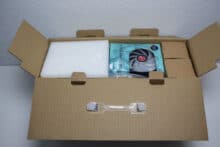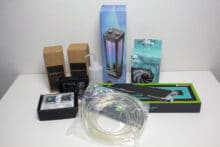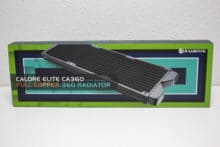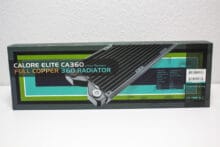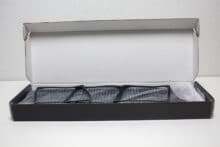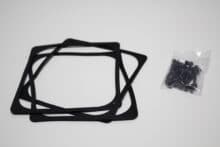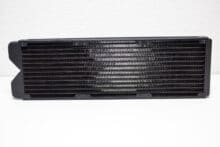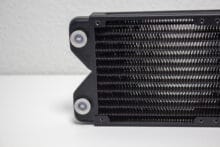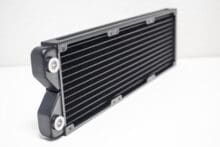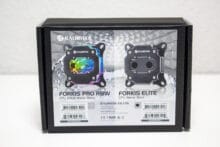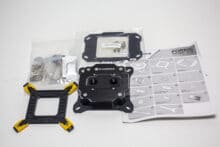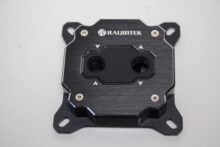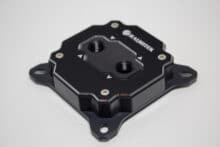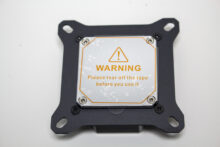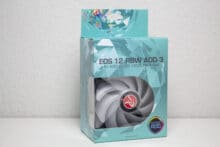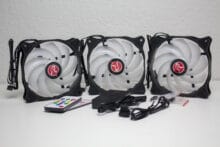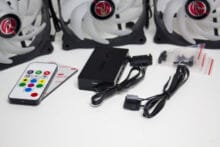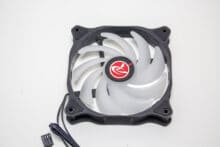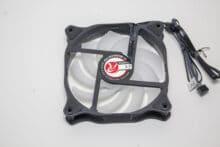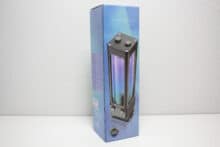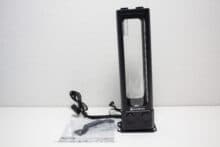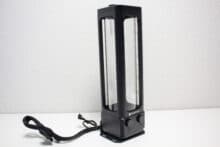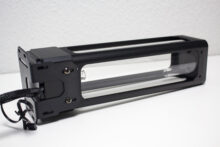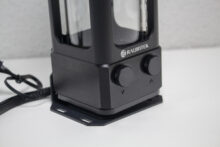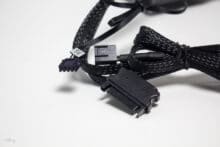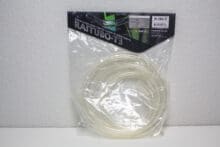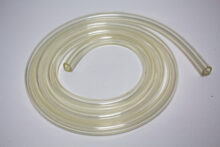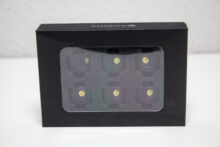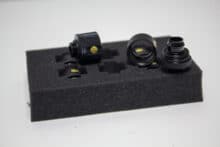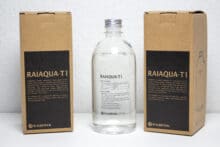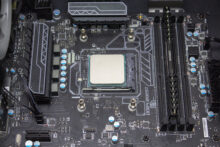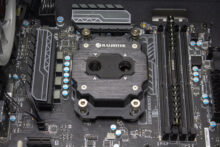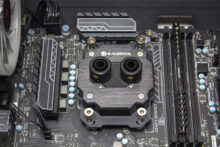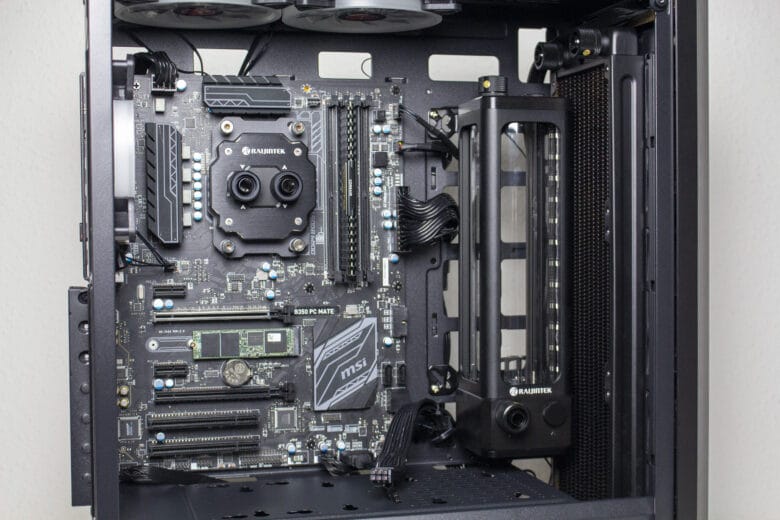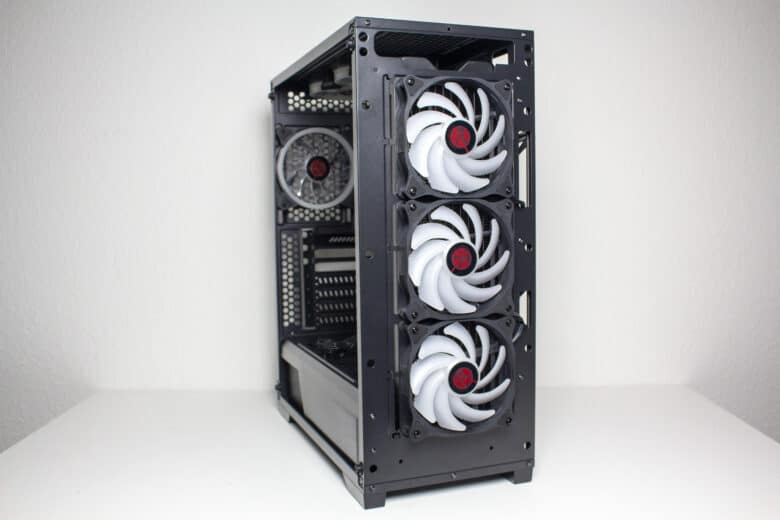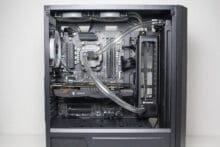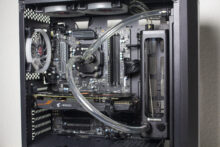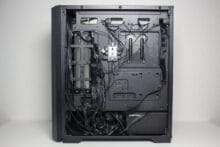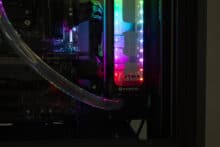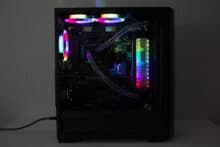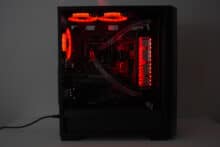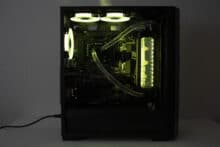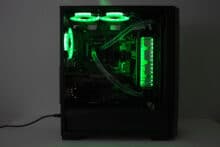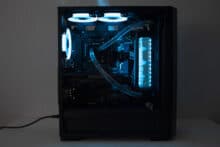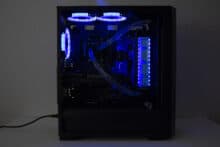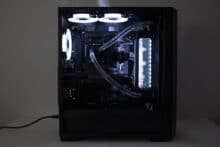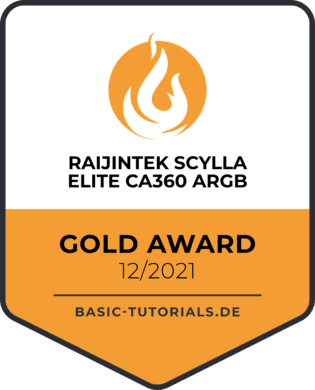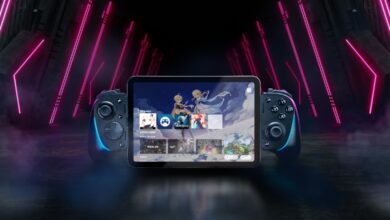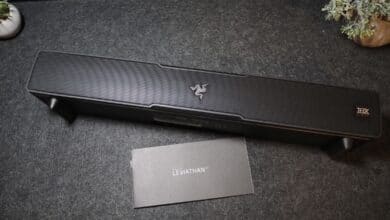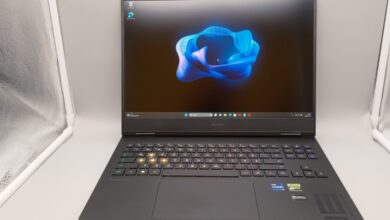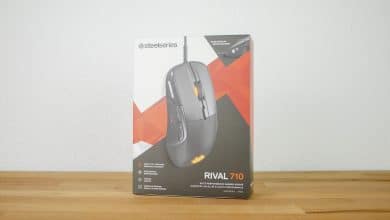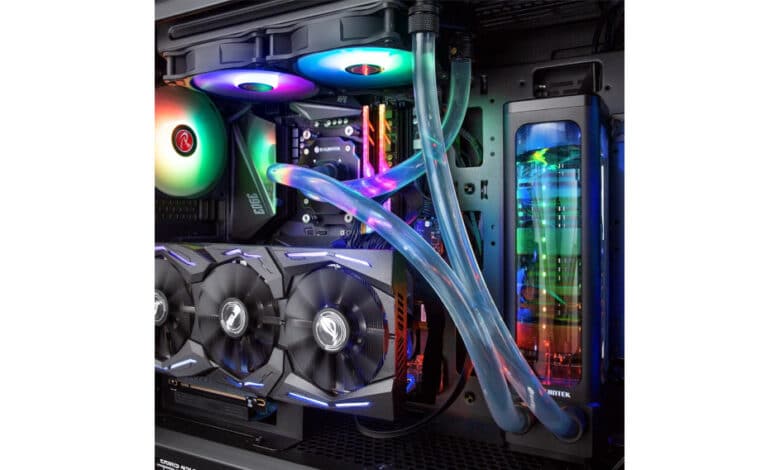
The Raijintek brand was founded in 2013 and is headquartered in Taiwan. The goal of the foundation was the development of high-end products in the lifestyle and IT hardware sector. The manufacturer mainly focuses on the development of cases, CPU coolers, water cooling systems and case fans. Raijintek’s most famous products are probably the ITX cases Metis and Ophion. Today, however, we won’t be taking a closer look at a case from Raijintek. Instead, we take a look at a custom water cooling kit.
Under the name Scylla, Raijintek has added four custom water cooling kits to its portfolio in the summer of 2021. Each of the kits includes everything needed to build a custom water cooling system for the processor. The “PRO” version relies on hard tubes and the “ELITE” version on soft tubes. In addition, there is a set with a 240 or 360 radiator in each case. All other parts such as fittings, hoses, coolant, fans and an expansion tank are of course also included and should make the water cooling start easier. Today we are testing the Scylla Elite CA360 ARGB package which comes with RGB effects and starts at a price of 275 euros (current: € 278.99 *).
Technical details
Radiator specifications
| Type | Calore CA360 |
| Dimensions | 393 x 120 x 27 mm (L x W x H) |
| Weight | 796 g |
| Material | Copper (black anodized) |
| Fin density (FPI) | 17 |
Specifications pump/balance tank
| Type | ANTILA DDC EVO RBW |
| Dimensions (total) | 80 x 292 x 95 mm (W x H x D) |
| Weight (with fan) | 1,180 g |
| Material | POM, glass, aluminum, steel |
| Color | Black (pump), Transparent (balance tank) |
| Height | 6.5 m |
| Throughput | 750 L/h |
| Pressure: | max. 50 PSI |
| Volume | max. 45 d(A) |
| Rotations | 1,800 to 4,800 rpm |
| Connection | SATA (power), 2510-3P (3-pin fan) |
| Voltage | 12 V |
| Current consumption | 1.8 A |
| Lighting | ARGB |
| Life | 50,000 h |
Specifications cooler
| Type | FORKIS ELITE |
| Dimensions (total) | 82 x 16 x 82 mm (W x H x D) |
| Weight (with fan) | 720 g |
| Material | Nickel-plated copper (radiator bottom), aluminum (cover), POM (lid) |
| Compatibility | LGA 775, 115x, 1366, 201x, 2066 (Intel). AM2(+), AM3(+), AM4 (AMD) |
Specifications RGB/Fan Controller
| Type | ARGB, 3-pin RGB (5VDG, 5V) |
| Connectors | 5x ARGB, 5x 4-pin PWM |
Fan specifications
| Type | EOS 12 RBW ADD |
| Number | 3 pieces |
| Dimensions | 120 x 120 x 25 mm |
| Weight | approx. 260g |
| Color | Black (frame), white (fan blades) |
| Bearing type | Sliding bearing |
| Speed | 800 – 1800 rpm |
| Supply volume | max. 127.4 m³/h |
| Static pressure | max. 2.3 mmH20 |
| Volume | max. 28 db(A) |
| Delivery volume | 127.7 m³/h |
| Voltage | 12 V |
| Starting voltage | 7 V |
| Connection | 4-pin PWM, 5V ADD header |
| Life expectancy | 40,000 h |



Packaging & Scope of delivery
Packed is the complete set from Raijintek in a plain brown cardboard box with carrying handle. In order to clarify which components are inside the packaging, the manufacturer has provided the front with a colored sticker. This already gives a first overview of the box’s contents. Raijintek has omitted additional technical information about the set on the box. If you open the upper flap, you are directly greeted by several polystyrene mats that are supposed to fill the free space. Below that, all the remaining components can be discovered. Included with this set are:
- 1x FORKIS ELITE CPU cooler
- 1x ANTILA DDC EVO RBW pump/reservoir
- 1x Calore Elite CA360 Triple Radiator (360 mm)
- 3x EOS 12 RBW ADD 120 mm fan
- 4x RAITUBO-T3 hose, 16/10 mm (OD/ID), 2 m – transparent
- 6x G1/4 inch to 16/10 mm outer/inner diameter (OD/ID) connectors – black
- 2x RAIAQUA-T1 coolant, 500 ml each
- 1x 5-port ARGB controller incl. remote control
- 1x thermal compound
- Mounting material for radiator, fan, AMD and Intel sockets
Overall, the packaging of the components seems well thought out and should prevent damage well during transport. Free spaces were sensibly filled by foam mats and prevent the individual boxes from flying back and forth.
Design & Workmanship
The radiator is named Calore Elite CA360 and comes from the house of Raijintek. Packaged in a colorful printed cardboard box and wrapped with bubble wrap, the Calore Elite offers space for three 120-millimeter fans. The radiator is made entirely of copper and has been painted black. The accessories also include three rubber rings to decouple the fans and all the necessary mounting screws.
The FORKIS ELITE cooling block also comes separately packaged in a black box used for both variants (with and without RGB). Also included in the box are mounting instructions, all necessary screws and spacers, as well as a backplate for Intel systems and a second mounting plate for AMD systems. Visually, the FORKIS ELITE has a rather restrained design and RGB effects have been completely omitted. The CPU block is made of aluminum (lid), nickel-plated copper (cooler base), plastic and steel (mounting frame). The mounting frame is attached to the bottom of the cooling block via four screws and can be removed.
Since the radiator has room for three 120-millimeter fans, they naturally come with the complete set with a corresponding number of fans. Also packaged separately, the EOS 12 RBW ADD each have a 4-pin PWM connector and a, supposedly proprietary, 3-pin 5V ARGB header. Moving the air is a rotor with nine milky white fan blades enclosed by a black frame. The fan package also comes with 12 mounting screws, an RGB and PWM control board, and a matching remote control. Alternatively, the control board can be connected directly to the motherboard via 4-pin PWM and 3-pin 5V ARGB connectors.
Besides the radiator, the expansion tank (AGB) with built-in pump consumes the most space in the box. The AGB pump combination is called ANTILA DDC EVO RBW and has a total height of about 300 millimeters. The case is mainly made of aluminium and includes the tank made of glass. Certain POM elements in the lid and the pump housing round off the design very well. In total, the unit has four G1/4-inch ports. The DDC pump has been placed below the tank and features a SATA power connector and a PWM connector for speed readout or control via the motherboard. Since the AGB also has an RGB light bar, a third cable can also be seen for connection to the RGB controller or the motherboard. All cables were sleeved in black.
The workmanship as well as painting of the AGB, radiator, the fans and the cooling block are overall on a very high level. All components look very valuable and are also optimally suited for a show system due to the RGB lighting.
Finally, the components for hosing and filling should not be missing. Raijintek has included a two meter long PVC tube (RAITUBO-T3) with an inner diameter of 10 and outer diameter of 13 millimeters. In addition, there are six matching softtube fittings (PELIAS D141806) for connecting to the CPU block, radiator and expansion tank. The whole set is then filled with one liter of coolant, which Raijintek offers under the product name RAIAQUA-T1.
Installation & Assembly
For the review of cooling system, we usually use a benchtable. However, in this case we make an exception and use the Raijintek Ponos MS4 as the water cooling support instead. Furthermore, the test system consists of the following components.
- AMD Ryzen 5 1400 @ 3.8 GHz (1.25 V)*
- MSI B350 PC MATE*
- Crucial Ballistix Sport LT gray 32 GB DDR4-3000
- Corsair Force Series MP510 960GB Nvme
- Gigabyte AORUS GTX 1060 6G
- LC-Power LC550 V2.31 Platinum Series 550W
We have already described to you in this article what exactly you have to consider with a custom watercooling and how the installation should be planned. Therefore, this review is explicitly not a tutorial on how to install a custom water cooler.
The Raijintek FORKIS ELITE CPU block is suitable for both Intel and AMD systems. Since we are testing on an AMD system, we first had to remove the mounting frame and attach the AMD frame to the cooling block. This required the removal of four screws. After that, the motherboard could be prepared for mounting.
In the next step, we turn our attention to mounting the balance tank. First, we attach the two supplied retaining clips to the back of the AGB. These allow it to be attached to a mounting location for two 120-millimeter fans. This could either be on the back of a radiator or, in our case, on the Pono’s motherboard tray. Screwing is done via four silver screws and matching nuts.
The last components we mount are the 360 radiator and the three RGB fans. To do this, we place the radiator inside and the fans outside the chassis. We then use the long screws to connect them to the radiator.
Now follow the screwing of the fittings to the CPU cooler, the radiator as well as the expansion tank. In the final step, all that remains is the tubing and wiring of all the fans and the pump. A small challenge was the connection between the radiator and the expansion tank. Here in our case the distance was just a little too small. Therefore, we had to put a small loop.
The very last step is filling the water circuit. To do this, we filled the coolant into the supplied bottle or subsequently into the radiator. A full AGB is enough to fill the circuit so far that the pump does not run dry. After two hours at maximum rpm of the pump, the circuit was almost free of air and we could look at the very fancy lighting and start the stress test.
Loudness and cooling performance
As pointed out in the previous chapter, we are using an AM4 system based on the Ryzen 5 1400 and the MSI B350 PC MATE as our test hardware. The Ryzen runs overclocked to 3.8 GHz at a voltage of 1.25 V. To heat up the processor, it was loaded with Prime95 for 20 minutes. The CPU’s temperature was then read out with the CPUID hardware monitor and the room temperature was around 19 °C during the measurements.
| Cooler | Operating scenario | RPM | temperature |
| AMD Wraith Stealth | 50% PWM | 1450 rpm | 95 °C |
| AMD Wraith Stealth | 100% PWM | 2650 rpm | 83 °C |
| LC-Power LC-CC-120-RGB | 50% PWM | 1000 rpm | 71 °C |
| LC-Power LC-CC-120-RGB | 100% PWM | 1800 rpm | 67 °C |
| Raijintek Scylla Elite CA360 ARGB | 50% PWM (pump, fan) | 850 rpm (fan) 3200 rpm (pump) |
53 °C |
| Raijintek Scylla Elite CA360 ARGB | 100% PWM (pump, fan | 1000 rpm (fan) 4000 rpm (pump) |
50 °C |
As is to be expected with a custom water cooler, a worst-case load on our mid-range CPU is not a challenge, and even the conventional CPU cooler with a 120-millimeter fan is far behind. Even with reduced fan speeds, the CPU’s temperature only increased slightly and was very far from critical levels. Unfortunately, since we don’t have a high-end CPU on hand, such as an Intel Core i9-12900K, we can only guess how the Scylla Elite CA360 ARGB would do here. However, we are very sure that even such a scenario should not be a problem for this set.
Conclusion on the Raijintek Scylla Elite CA360 ARGB custom water cooling
Raijintek delivers a very interesting complete set with the Scylla Elite CA360 ARGB. The set includes all relevant components necessary for the initial setup of a custom water cooling system. As you would expect, all parts are designed as standard and allow for expansion with additional components. Since the pump also has a very strong flow rate, additional radiators or a GPU hump should not be a problem. We were also impressed by the basically very good workmanship of all set components.
Of course, the disadvantages of a custom water cooling system have to be weighed up. It is not maintenance-free and the risk of a leak is usually higher than with an AiO water cooling system. In addition, the maintenance effort is higher. Finally, you should consider exactly which components should actually be cooled beforehand. A simple mid-range CPU that is only slightly overclocked does not usually require a custom water cooling system. If, on the other hand, a high-end CPU including GPU is to be cooled, then a custom water cooling system can definitely make sense.
If you want to enter the wide world of custom watercooling, you can get the Raijintek Scylla Elite CA360 ARGB, a comparatively inexpensive complete set, which does not have to hide from the well-known competition due to its chic look and high-quality workmanship. If you want even more RGB and can not do without hardtubes, Raijintek would also have something in store with the variant “PRO”.
Raijintek Scylla Elite CA360 ARGB
Design
Workmanship
Assembly
Cooling
Value for money
90/100
The Scylla Elite CA360 ARGB complete water cooling set from Raijintek has a high-quality build, is powerful and can convince with chic RGB effects. The whole thing is available at an attractive price.





